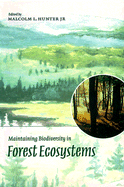Book contents
- Frontmatter
- Contents
- List of contributors
- Foreword
- Preface
- Part I Introduction
- Part II The macro approach, managing forest landscapes
- 3 Species composition
- 4 Dynamic forest mosaics
- 5 Abiotic factors [161]
- 6 Forest edges
- 7 Islands and fragments
- 8 Riparian forests
- 9 Forested wetlands
- Part III The micro approach, managing forest stands
- Part IV Synthesis and implementation
- Index
8 - Riparian forests
Published online by Cambridge University Press: 20 February 2010
- Frontmatter
- Contents
- List of contributors
- Foreword
- Preface
- Part I Introduction
- Part II The macro approach, managing forest landscapes
- 3 Species composition
- 4 Dynamic forest mosaics
- 5 Abiotic factors [161]
- 6 Forest edges
- 7 Islands and fragments
- 8 Riparian forests
- 9 Forested wetlands
- Part III The micro approach, managing forest stands
- Part IV Synthesis and implementation
- Index
Summary
Only a small portion of most landscapes are occupied by riparian forests. While the contribution of these ecosystems to sustaining aquatic organisms is profound (Gregory et al. 1991), they also have a central role in sustaining a variety of terrestrial organisms, ranging from microbes to vertebrates. In most parts of the world, floodplain or riparian zones are dominated by trees. Particularly in arid regions, they may be the only sites supporting forested conditions. In such climates, the structure and species composition of vegetation are not only distinct from surrounding uplands, but species assemblages change over short distances making riparian forests diverse if only because of the steep environmental gradients that they contain. This chapter examines the reasons for this diversity, describes common threats, makes suggestions on how impacts to them may be minimized, and oers suggestions for their restoration.
What are riparian forests?
Riparian forests are located on river floodplains, and are part of a highly integrated system that includes the stream channel. Overlapping terms are riverine wetlands (Brinson 1990) and riparian corridors (Naiman et al. 1993). Riparian forest is the vegetated portion of the riparian corridor that Naiman et al. (1993) describe as ‘… that portion of the terrestrial landscape from the high water mark towards the uplands where vegetation may be influenced by elevated water tables or flooding, and by the ability of soils to hold water.’ An analogous term for riparian zone is ‘river marginal’, particularly in the European literature (Maltby et al. 1996). Not all riparian zones or river marginal areas are forested in their natural condition, however.
- Type
- Chapter
- Information
- Maintaining Biodiversity in Forest Ecosystems , pp. 265 - 299Publisher: Cambridge University PressPrint publication year: 1999
- 23
- Cited by

